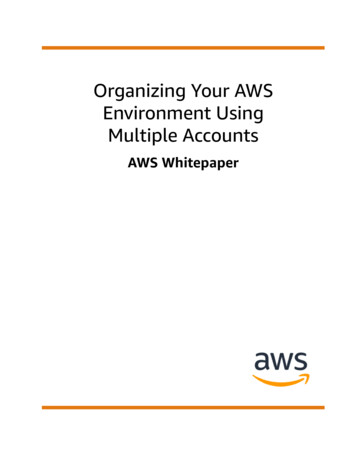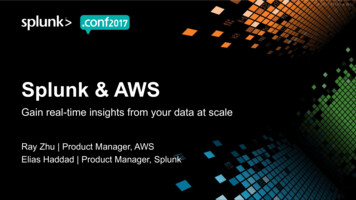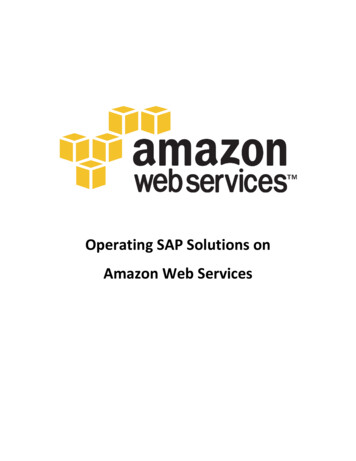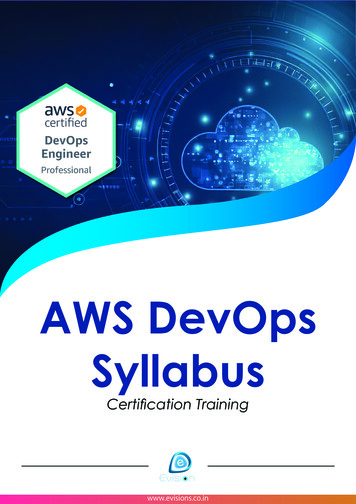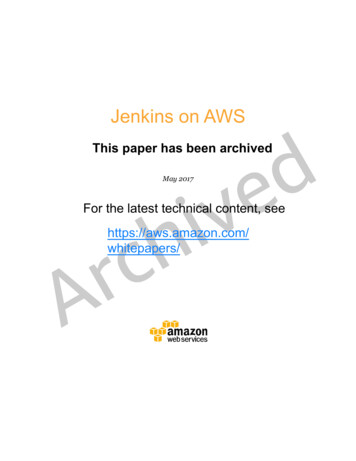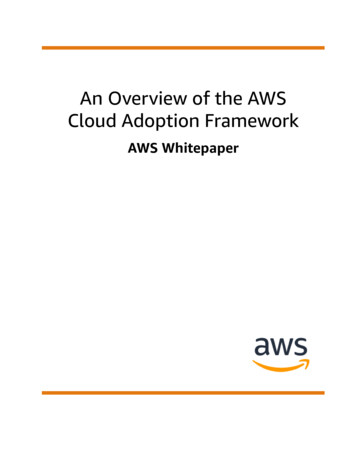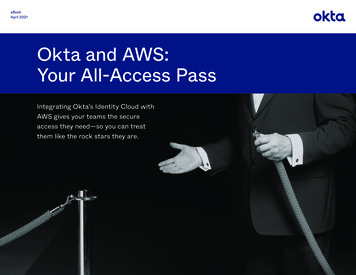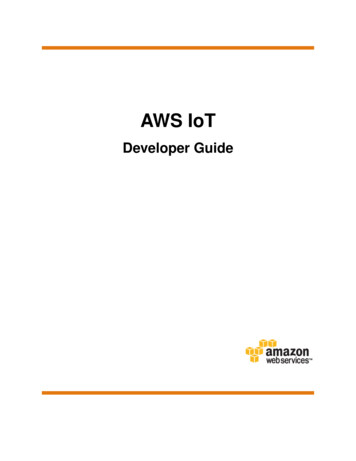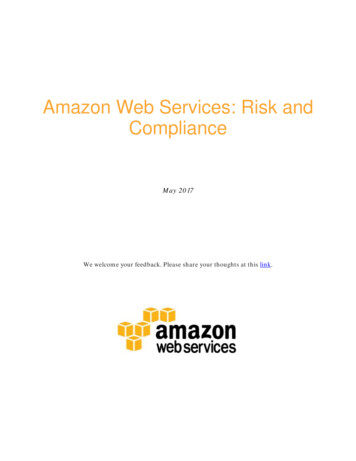
Transcription
Amazon Web Services: Risk andComplianceMay 2017We welcome your feedback. Please share your thoughts at this link.
Amazon Web Services Risk and ComplianceMay 2017This document is intended to provide information to assist AWS customers with integrating AWS into theirexisting control framework supporting their IT environment. This document includes a basic approach toevaluating AWS controls and provides information to assist customers with integrating control environments.This document also addresses AWS-specific information around general cloud computing compliancequestions.Table of ContentsRisk and Compliance Overview .3Shared Responsibility Environment . 3Strong Compliance Governance . 4Evaluating and Integrating AWS Controls .4AWS IT Control Information . 5AWS Global Regions . 5AWS Risk and Compliance Program .6Risk Management . 6Control Environment . 6Information Security . 7AWS Certifications, Programs, Reports, and Third-Party Attestations.7CJIS . 7CSA . 7Cyber Essentials Plus . 8DoD SRG Levels 2 and 4 . 8FedRAMP SM . 8FERPA . 9FIPS 140-2 . 9FISMA and DIACAP . 9GxP . 9HIPAA . 10IRAP . 10ISO 9001 . 10ISO 27001 . 11ISO 27017. 11ISO 27018 . 12ITAR . 12MPAA . 12MTCS Tier 3 Certification . 13Page 2 of 81
Amazon Web Services Risk and ComplianceMay 2017NIST . 13PCI DSS Level 1. 13SOC 1/ISAE 3402 . 14SOC 2 . 15SOC 3 . 15Key Compliance Questions and AWS. 15AWS Contact .20Appendix A: CSA Consensus Assessments Initiative Questionnaire v3.0.1 .21Appendix B: AWS alignment with the Australian Signals Directorate (ASD) Cloud ComputingSecurity Considerations .57Appendix C: Glossary of Terms .77Risk and Compliance OverviewAWS and its customers share control over the IT environment, both parties have responsibility for managingthe IT environment. AWS’ part in this shared responsibility includes providing its services on a highly secureand controlled platform and providing a wide array of security features customers can use. The customers’responsibility includes configuring their IT environments in a secure and controlled manner for their purposes.While customers don’t communicate their use and configurations to AWS, AWS does communicate its securityand control environment relevant to customers. AWS does this by doing the following: Obtaining industry certifications and independent third-party attestations described in this documentPublishing information about the AWS security and control practices in whitepapers and web sitecontentProviding certificates, reports, and other documentation directly to AWS customers under NDA (asrequired)For a more detailed description of AWS security please see:AWS Security Center: https://aws.amazon.com/security/For a more detailed description of AWS Compliance please seeAWS Compliance page: https://aws.amazon.com/compliance/Additionally, The AWS Overview of Security Processes Whitepaper covers AWS’ general security controls andservice-specific security.Shared Responsibility EnvironmentMoving IT infrastructure to AWS services creates a model of shared responsibility between the customer andAWS. This shared model can help relieve customer’s operational burden as AWS operates, manages andcontrols the components from the host operating system and virtualization layer down to the physical securityof the facilities in which the service operates. The customer assumes responsibility and management of theguest operating system (including updates and security patches), other associated application software as wellas the configuration of the AWS provided security group firewall. Customers should carefully consider theservices they choose as their responsibilities vary depending on the services used, the integration of thosePage 3 of 81
Amazon Web Services Risk and ComplianceMay 2017services into their IT environment, and applicable laws and regulations. It is possible for customers to enhancesecurity and/or meet their more stringent compliance requirements by leveraging technology such as hostbased firewalls, host based intrusion detection/prevention, encryption and key management. The nature of thisshared responsibility also provides the flexibility and customer control that permits the deployment ofsolutions that meet industry-specific certification requirements.This customer/AWS shared responsibility model also extends to IT controls. Just as the responsibility tooperate the IT environment is shared between AWS and its customers, so is the management, operation andverification of IT controls shared. AWS can help relieve customer burden of operating controls by managingthose controls associated with the physical infrastructure deployed in the AWS environment that maypreviously have been managed by the customer. As every customer is deployed differently in AWS, customerscan take advantage of shifting management of certain IT controls to AWS which results in a (new) distributedcontrol environment. Customers can then use the AWS control and compliance documentation available tothem (described in the AWS Certifications and Third-party Attestations section of this document) to performtheir control evaluation and verification procedures as required.The next section provides an approach on how AWS customers can evaluate and validate their distributedcontrol environment effectively.Strong Compliance GovernanceAs always, AWS customers are required to continue to maintain adequate governance over the entire IT controlenvironment regardless of how IT is deployed. Leading practices include an understanding of requiredcompliance objectives and requirements (from relevant sources), establishment of a control environment thatmeets those objectives and requirements, an understanding of the validation required based on theorganization’s risk tolerance, and verification of the operating effectiveness of their control environment.Deployment in the AWS cloud gives enterprises different options to apply various types of controls and variousverification methods.Strong customer compliance and governance might include the following basic approach:1. Review information available from AWS together with other information to understand as much ofthe entire IT environment as possible, and then document all compliance requirements.2. Design and implement control objectives to meet the enterprise compliance requirements.3. Identify and document controls owned by outside parties.4. Verify that all control objectives are met and all key controls are designed and operating effectively.Approaching compliance governance in this manner will help companies gain a better understanding of theircontrol environment and will help clearly delineate the verification activities to be performed.Evaluating and Integrating AWS ControlsAWS provides a wide range of information regarding its IT control environment to customers through whitepapers, reports, certifications, and other third-party attestations. This documentation assists customers inunderstanding the controls in place relevant to the AWS services they use and how those controls have beenvalidated. This information also assists customers in their efforts to account for and to validate that controls intheir extended IT environment are operating effectively.Traditionally, the design and operating effectiveness of control objectives and controls are validated by internaland/or external auditors via process walkthroughs and evidence evaluation. Direct observation/verification, bythe customer or customer’s external auditor, is generally performed to validate controls. In the case wherePage 4 of 81
Amazon Web Services Risk and ComplianceMay 2017service providers, such as AWS, are used, companies request and evaluate third-party attestations andcertifications in order to gain reasonable assurance of the design and operating effectiveness of controlobjective and controls. As a result, although customer’s key controls may be managed by AWS, the controlenvironment can still be a unified framework where all controls are accounted for and are verified as operatingeffectively. Third-party attestations and certifications of AWS can not only provide a higher level of validationof the control environment, but may relieve customers of the requirement to perform certain validation workthemselves for their IT environment in the AWS cloud.AWS IT Control InformationAWS provides IT control information to customers in the following two ways:1. Specific control definition. AWS customers are able to identify key controls managed by AWS. Keycontrols are critical to the customer’s control environment and require an external attestation of theoperating effectiveness of these key controls in order to comply with compliance requirements—such asthe annual financial audit. For this purpose, AWS publishes a wide range of specific IT controls in itsService Organization Controls 1 (SOC 1) Type II report. The SOC 1 report, formerly the Statement onAuditing Standards (SAS) No. 70, Service Organizations report, is a widely recognized auditingstandard developed by the American Institute of Certified Public Accountants (AICPA). The SOC 1 auditis an in-depth audit of both the design and operating effectiveness of AWS’ defined control objectivesand control activities (which include control objectives and control activities over the part of theinfrastructure AWS manages). “Type II” refers to the fact that each of the controls described in thereport are not only evaluated for adequacy of design, but are also tested for operating effectiveness bythe external auditor. Because of the independence and competence of AWS’ external auditor, controlsidentified in the report should provide customers with a high level of confidence in AWS’ controlenvironment. AWS’ controls can be considered designed and operating effectively for many compliancepurposes, including Sarbanes-Oxley (SOX) Section 404 financial statement audits. Leveraging SOC 1Type II reports is also generally permitted by other external certifying bodies (e.g., ISO 27001 auditorsmay request a SOC 1 Type II report in order to complete their evaluations for customers).Other specific control activities relate to AWS’ Payment Card Industry (PCI) and Federal Information SecurityManagement Act (FISMA) compliance. As discussed below, AWS is compliant with FISMA Moderate standardsand with the PCI Data Security Standard. These PCI and FISMA standards are very prescriptive and requireindependent validation that AWS adheres to the published standard.2. General control standard compliance. If an AWS customer requires a broad set of controlobjectives to be met, evaluation of AWS’ industry certifications may be performed. With the AWS ISO27001 certification, AWS complies with a broad, comprehensive security standard and follows bestpractices in maintaining a secure environment. With the PCI Data Security Standard (PCI DSS), AWScomplies with a set of controls important to companies that handle credit card information. With AWS’compliance with the FISMA standards, AWS complies with a wide range of specific controls required byUS government agencies. Compliance with these general standards provides customers with in-depthinformation on the comprehensive nature of the controls and security processes in place and can beconsidered when managing compliance.AWS Global RegionsData centers are built in clusters in various global regions, including: US East (Northern Virginia), US West(Oregon), US West (Northern California), AWS GovCloud (US) (Oregon), EU (Frankfurt), EU (Ireland), AsiaPacific (Seoul) Asia Pacific (Singapore), Asia Pacific (Tokyo), Asia Pacific (Sydney), China (Beijing), and SouthAmerica (Sao Paulo).For a complete list of regions, see the AWS Global Infrastructure page.Page 5 of 81
Amazon Web Services Risk and ComplianceMay 2017AWS Risk and Compliance ProgramAWS provides information about its risk and compliance program to enable customers to incorporate AWScontrols into their governance framework. This information can assist customers in documenting a completecontrol and governance framework with AWS included as an important part of that framework.Risk ManagementAWS management has developed a strategic business plan which includes risk identification and theimplementation of controls to mitigate or manage risks. AWS management re-evaluates the strategic businessplan at least biannually. This process requires management to identify risks within its areas of responsibilityand to implement appropriate measures designed to address those risks.In addition, the AWS control environment is subject to various internal and external risk assessments. AWS’Compliance and Security teams have established an information security framework and policies based on theControl Objectives for Information and related Technology (COBIT) framework and have effectively integratedthe ISO 27001 certifiable framework based on ISO 27002 controls, American Institute of Certified Public Accountants(AICPA) Trust Services Principles, the PCI DSS v3.2, and the National Institute of Standards and Technology (NIST)Publication 800-53 Rev 3 (Recommended Security Controls for Federal Information Systems). AWS maintainsthe security policy, provides security training to employees, and performs application security reviews. Thesereviews assess the confidentiality, integrity, and availability of data, as well as conformance to the informationsecurity policy.AWS Security regularly scans all Internet facing service endpoint IP addresses for vulnerabilities (these scansdo not include customer instances). AWS Security notifies the appropriate parties to remediate any identifiedvulnerabilities. In addition, external vulnerability threat assessments are performed regularly by independentsecurity firms. Findings and recommendations resulting from these assessments are categorized and deliveredto AWS leadership. These scans are done in a manner for the health and viability of the underlying AWSinfrastructure and are not meant to replace the customer’s own vulnerability scans required to meet theirspecific compliance requirements. Customers can request permission to conduct scans of their cloudinfrastructure as long as they are limited to the customer’s instances and do not violate the AWS AcceptableUse Policy. Advance approval for these types of scans can be initiated by submitting a request via the AWSVulnerability / Penetration Testing Request Form.Control EnvironmentAWS manages a comprehensive control environment that includes policies, processes and control activitiesthat leverage various aspects of Amazon’s overall control environment. This control environment is in place forthe secure delivery of AWS’ service offerings. The collective control environment encompasses the people,processes, and technology necessary to establish and maintain an environment that supports the operatingeffectiveness of AWS’ control framework. AWS has integrated applicable cloud-specific controls identified byleading cloud computing industry bodies into the AWS control framework. AWS continues to monitor theseindustry groups for ideas on which leading practices can be implemented to better assist customers withmanaging their control environment.The control environment at Amazon begins at the highest level of the Company. Executive and seniorleadership play important roles in establishing the Company’s tone and core values. Every employee isprovided with the Company’s Code of Business Conduct and Ethics and completes periodic training.Compliance audits are performed so that employees understand and follow the established policies.Page 6 of 81
Amazon Web Services Risk and ComplianceMay 2017The AWS organizational structure provides a framework for planning, executing and controlling businessoperations. The organizational structure assigns roles and responsibilities to provide for adequate staffing,efficiency of operations, and the segregation of duties. Management has also established authority andappropriate lines of reporting for key personnel. Included as part of the Company’s hiring verificationprocesses are education, previous employment, and, in some cases, background checks as permitted by law andregulation for employees commensurate with the employee’s position and level of access to AWS facilities. TheCompany follows a structured on-boarding process to familiarize new employees with Amazon tools, processes,systems, policies and procedures.Information SecurityAWS has implemented a formal information security program designed to protect the confidentiality, integrity,and availability of customers’ systems and data. AWS publishes a security whitepaper that is available on thepublic website that addresses how AWS can help customers secure their data.AWS Certifications, Programs, Reports, and Third-PartyAttestationsAWS engages with external certifying bodies and independent auditors to provide customers with considerableinformation regarding the policies, processes, and controls established and operated by AWS.CJISAWS complies with the FBI's Criminal Justice Information Services (CJIS) standard. We sign CJIS securityagreements with our customers, including allowing or performing any required employee background checksaccording to the CJIS Security Policy.Law enforcement customers (and partners who manage CJI) are taking advantage of AWS services to improvethe security and protection of CJI data, using the advanced security services and features of AWS, such asactivity logging (AWS CloudTrail), encryption of data in motion and at rest (S3’s Server-Side Encryptionwith the option to bring your own key), comprehensive key management and protection (AWS KeyManagement Service and CloudHSM), and integrated permission management (IAM federated identitymanagement, multi-factor authentication).AWS has created a Criminal Justice Information Services (CJIS) Workbook in a security plan templateformat aligned to the CJIS Policy Areas. Additionally, a CJIS Whitepaper has been developed to help guidecustomers in their journey to cloud adoption.Visit the CJIS Hub Page: https://aws.amazon.com/compliance/cjis/CSAIn 2011, the Cloud Security Alliance (CSA) launched STAR, an initiative to encourage transparency of securitypractices within cloud providers. The CSA Security, Trust & Assurance Registry (STAR) is a free, publiclyaccessible registry that documents the security controls provided by various cloud computing offerings, therebyhelping users assess the security of cloud providers they currently use or are considering contracting with.AWS is a CSA STAR registrant and has completed the Cloud Security Alliance (CSA) ConsensusAssessments Initiative Questionnaire (CAIQ). This CAIQ published by the CSA provides a way to reference andPage 7 of 81
Amazon Web Services Risk and ComplianceMay 2017document what security controls exist in AWS’ Infrastructure as a Service offerings. The CAIQ provides 298questions a cloud consumer and cloud auditor may wish to ask of a cloud provider.See: Appendix A: CSA Consensus Assessments Initiative Questionnaire v3.0.1Cyber Essentials PlusCyber Essentials Plus is a UK Government-backed, industry-supported certification scheme introduced inthe UK to help organizations demonstrate operational security against common cyber-attacks.It demonstrates the baseline controls AWS implements to mitigate the risk from common Internet-basedthreats, within the context of the UK Government's "10 Steps to Cyber Security". It is backed by industry,including the Federation of Small Businesses, the Confederation of British Industry and a number of insuranceorganizations that offer incentives for businesses holding this certification.Cyber Essentials sets out the necessary technical controls; the related assurance framework shows how theindependent assurance process works for Cyber Essentials Plus certification through an annual externalassessment conducted by an accredited assessor. Due to the regional nature of the certification, thecertification scope is limited to EU (Ireland) region.DoD SRG Levels 2 and 4The Department of Defense (DoD) Cloud Security Model (SRG) provides a formalized assessmentand authorization process for cloud service providers (CSPs) to gain a DoD Provisional Authorization, whichcan subsequently be leveraged by DoD customers. A Provisional Authorization under the SRG provides areusable certification that attests to our compliance with DoD standards, reducing the time necessary for a DoDmission owner to assess and authorize one of their systems for operation on AWS. AWS currently holdsprovisional authorizations at Levels 2 and 4 of the SRG.Additional information of the security control baselines defined for Levels 2, 4, 5, and 6 can be found at:http://iase.disa.mil/cloud security/Pages/index.aspx.Visit the DoD Hub Page: https://aws.amazon.com/compliance/dod/FedRAMP SMAWS is a Federal Risk and Authorization Management Program (FedRAMPsm) Compliant Cloud ServiceProvider. AWS has completed the testing performed by a FedRAMPsm accredited Third-Party AssessmentOrganization (3PAO) and has been granted two Agency Authority to Operate (ATOs) by the US Department ofHealth and Human Services (HHS) after demonstrating compliance with FedRAMPsm requirements at theModerate impact level. All U.S. government agencies can leverage the AWS Agency ATO packages stored in theFedRAMPsm repository to evaluate AWS for their applications and workloads, provide authorizations to useAWS, and transition workloads into the AWS environment. The two FedRAMPsm Agency ATOs encompass allU.S. regions (the AWS GovCloud (US) region and the AWS US East/West regions).For a complete list of the services that are in the accreditation boundary for the regions stated above, see theAWS Services in Scope by Compliance Program page e/).For more information on AWS FedRAMPsm compliance please see the AWS FedRAMPsm FAQs at:Page 8 of 81
Amazon Web Services Risk and ComplianceMay AThe Family Educational Rights and Privacy Act (FERPA) (20 U.S.C. § 1232g; 34 CFR Part 99) is aFederal law that protects the privacy of student education records. The law applies to all schools that receivefunds under an applicable program of the U.S. Department of Education. FERPA gives parents certain rightswith respect to their children's education records. These rights transfer to the student when he or she reachesthe age of 18, or attends a school beyond the high school level. Students to whom the rights have transferredare "eligible students."AWS enables covered entities and their business associates subject to FERPA to leverage the secure AWSenvironment to process, maintain, and store protected education information.AWS also offers a FERPA-focused whitepaper for customers interested in learning more about how theycan leverage AWS for the processing and storage of educational data.The "FERPA Compliance on AWS Whitepaper" outlines how companies can use AWS to process systemsthat facilitate FERPA mpliance/AWS FERPA Whitepaper.pdfFIPS 140-2The Federal Information Processing Standard (FIPS) Publication 140-2 is a US governmentsecurity standard that specifies the security requirements for cryptographic modules protecting sensitiveinformation. To support customers with FIPS 140-2 requirements, SSL terminations in AWS GovCloud (US)operate using FIPS 140-2 validated hardware. AWS works with AWS GovCloud (US) customers to provide theinformation they need to help manage compliance when using the AWS GovCloud (US) environment.FISMA and DIACAPAWS e
Service Organization Controls 1 (SOC 1) Type II report. The SOC 1 report, formerly the Statement on Auditing Standards (SAS) No. 70, Service Organizations report, is a widely recognized auditing standard developed by the American Institute of Certified Public Accountants (AICPA). The SOC 1 audit

